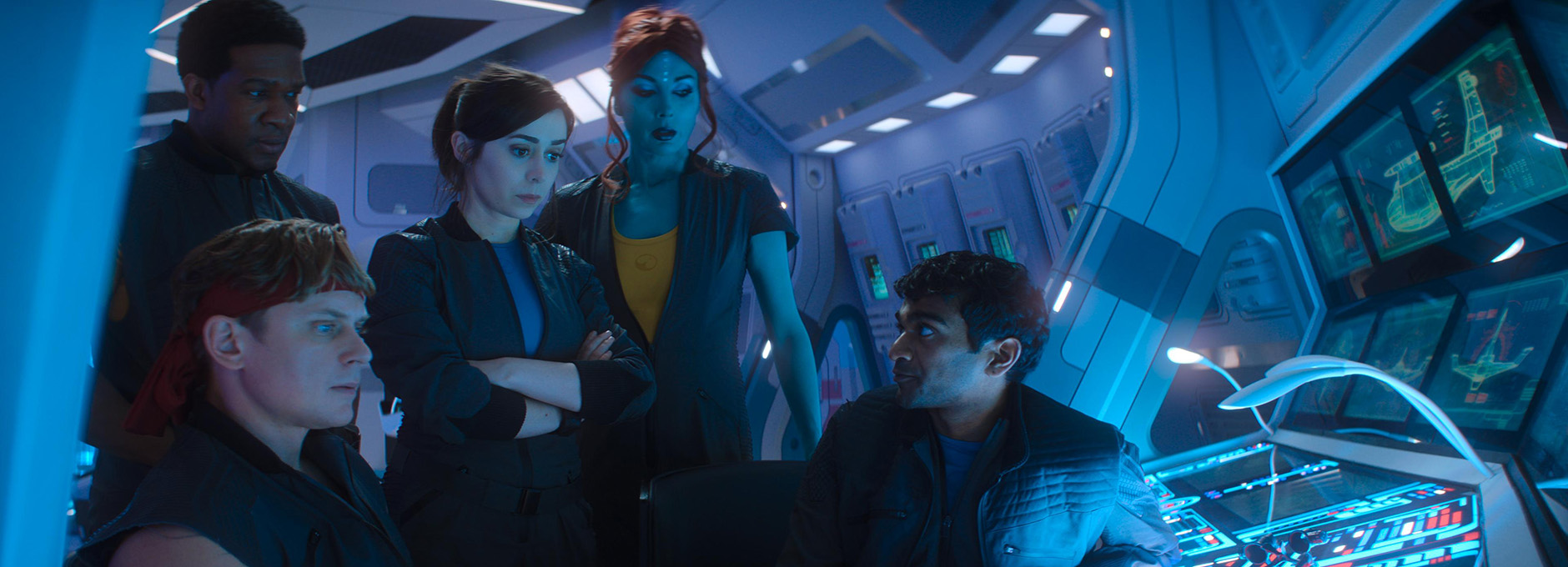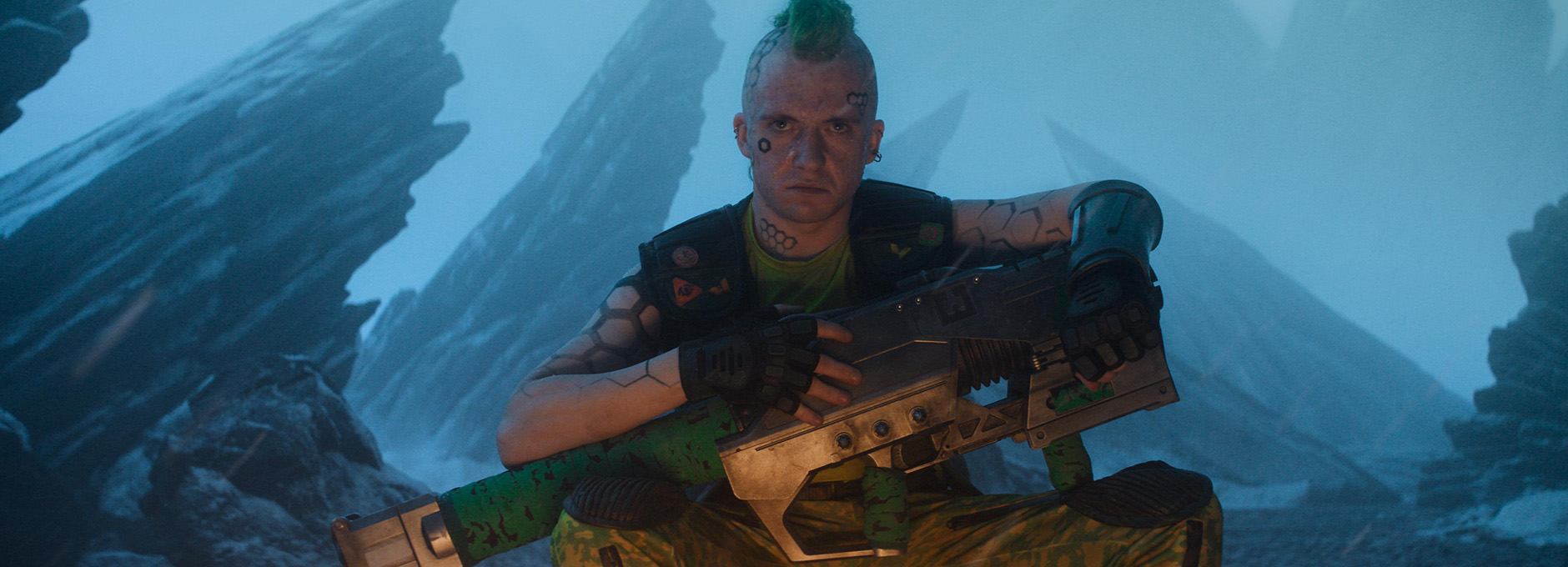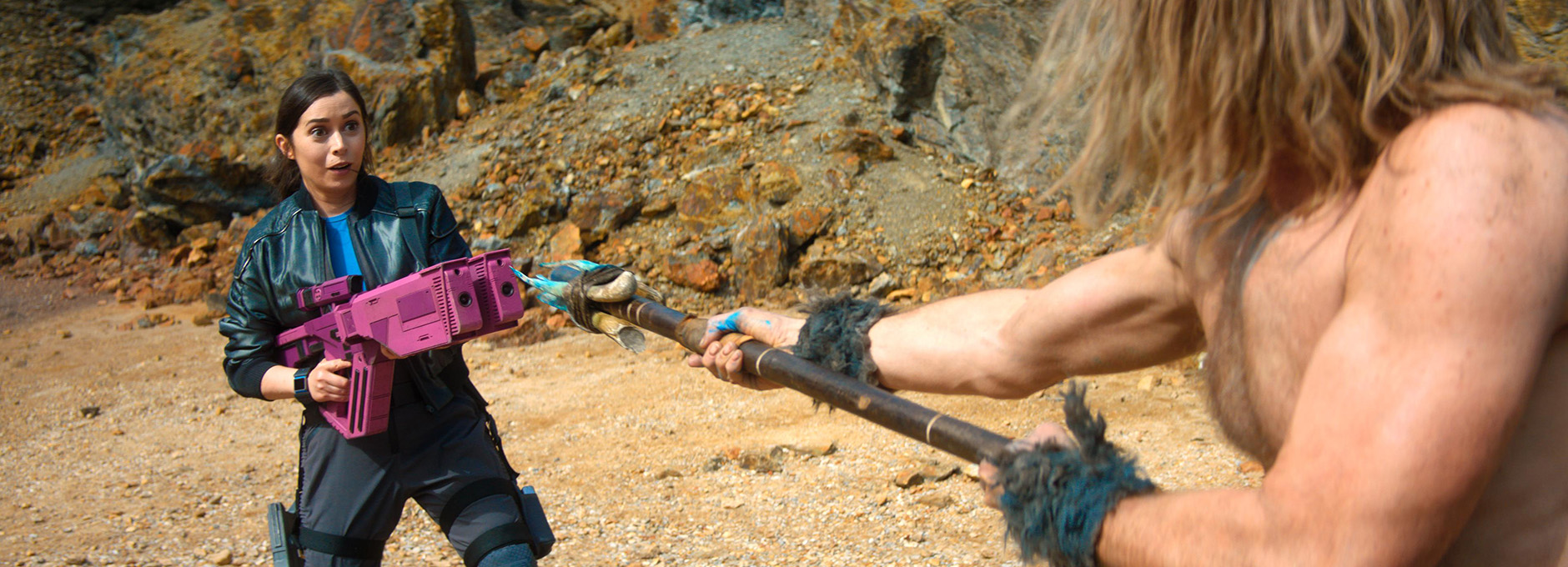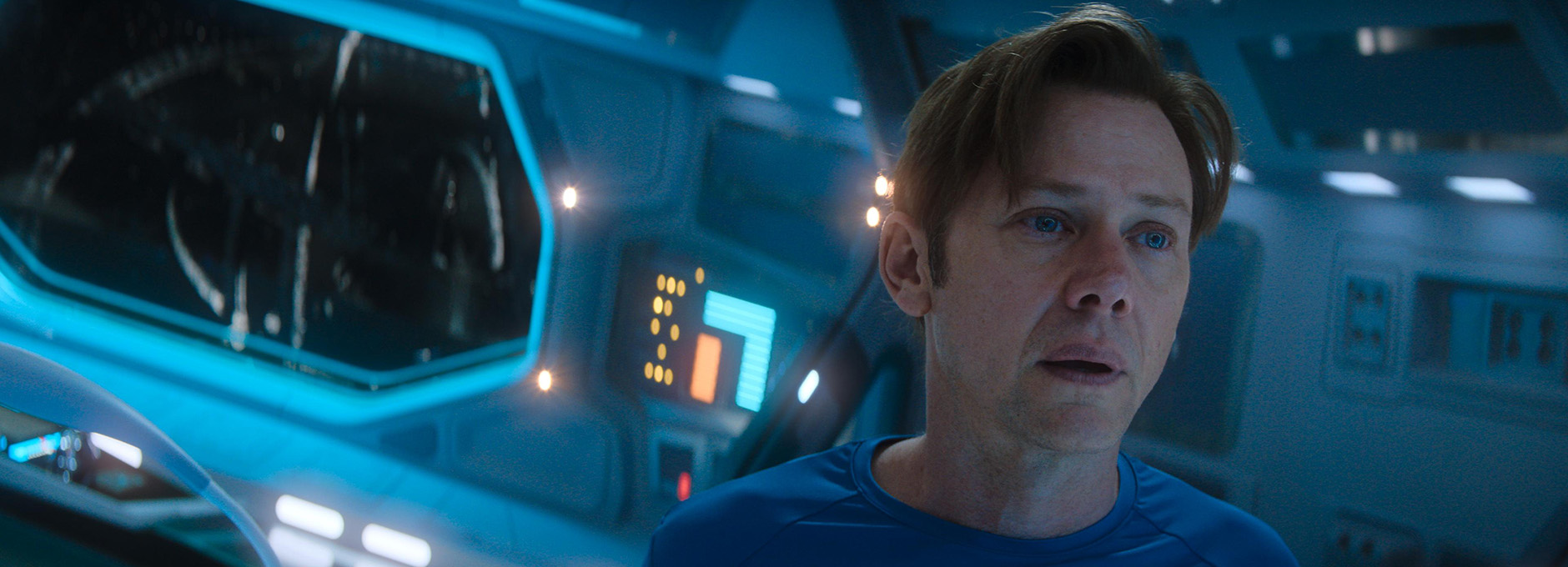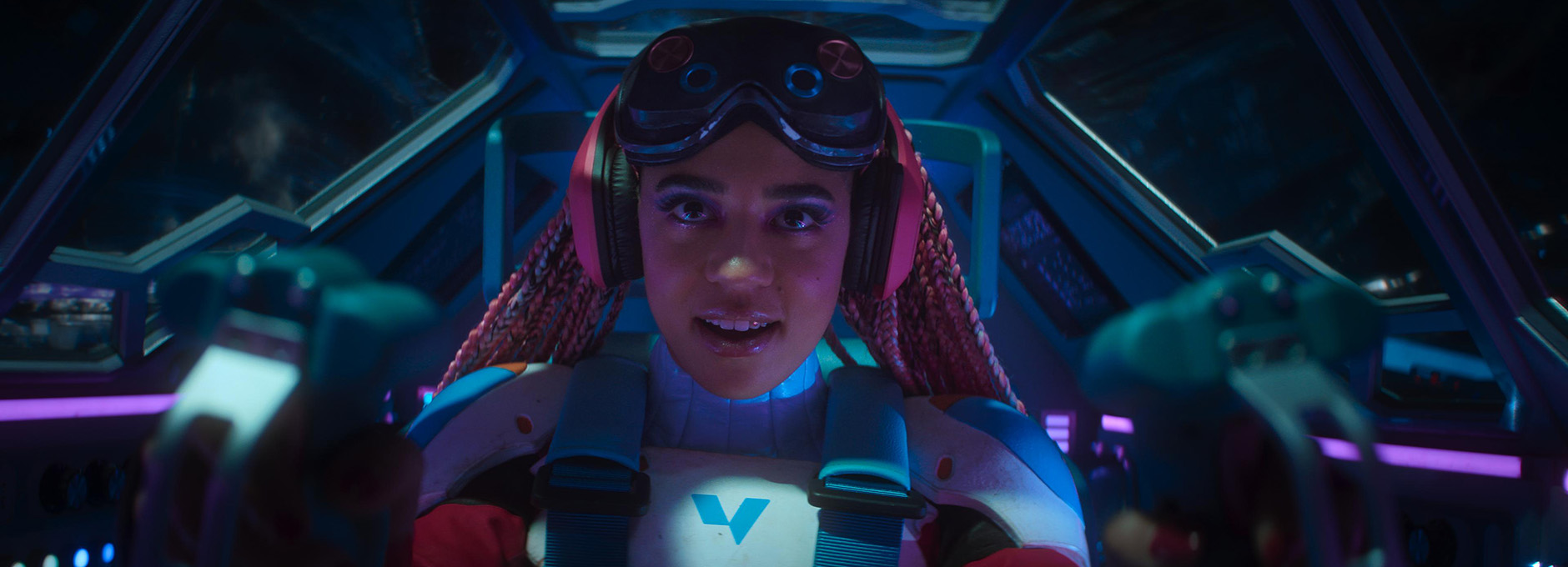Case Studies
The aesthetics of dystopia:
Colour grading Black Mirror season 7
PART ONE
In this three-part series, we go behind the scenes of three episodes from the latest season of Black Mirror, with senior colourist Sam Chynoweth at The Farm.
See: PART ONE | PART TWO | PART THREE
Season 7 of Black Mirror, released on 8 April, continues the series’ tradition of exploring the dark intersections of technology and human nature. The season is made up of six episodes, each delving into unique dystopian narratives that challenge viewers' perceptions of reality and innovation, exploring themes from the consequences of digital immortality to the ethical dilemmas of advanced surveillance technologies.
The season showcases a diverse array of directors, bringing fresh perspectives to the series, but one constant across five of the six episodes was senior colourist Sam Chynoweth at The Farm.
The Black Mirror legacy
For Chynoweth, grading Black Mirror was a dream job.
“I have been a longtime fan, so being given the opportunity to contribute to such a well-regarded series was a real privilege,” says Chynoweth. “Naturally, there’s a bit of pressure that comes with that – the show has a strong legacy of bold, visually distinctive storytelling, and every episode is expected to stand on its own both narratively and stylistically.”
Season 7 is made up of six episodes, with two of them running near feature length.
“What makes Black Mirror so unique is that no two episodes look or feel the same, which is incredibly exciting but also demands a lot of creative discipline,” adds Chynoweth. “With five episodes on my to-do list, I knew that maintaining clear visual separation between them would take an extra level of awareness and intent. Each had to have its own tone, palette, and texture, all while fitting within the broader Black Mirror universe.”
This challenge was largely what made the experience so rewarding for Chynoweth.
“It pushed me creatively and technically in all the right ways, and I feel lucky to have been part of a team that values visual storytelling so deeply.”
A shared ethos
Each episode was treated as a standalone project from a production perspective, and this philosophy extended to the grade, too.
“Every episode has its own look development, its own schedule, and its own finishing plan,” explains Chynoweth. “While there’s no overarching visual style that ties the entire season together, there is a shared ethos: to support each story with a distinct, purposeful aesthetic. Some episodes lean into bold stylisation; others are more restrained and naturalistic.”
For Chynoweth, overlapping schedules, varied workflows, and different creative teams, meant it required real care to ensure each story remained visually self-contained.
“That individuality is also what made the project so rewarding,” says Chynoweth. “The variety created space for a huge amount of creative expression. From evoking the cinematic language of the 1940s in Hotel Reverie, to crafting the nostalgic softness that underpins Eulogy, to building the scale and blockbuster energy of USS Callister: Into Infinity, each episode presented its own creative challenge. Exploring those questions made this season a real joy to work on.”
EPISODE 6: USS Callister: Into Infinity
USS Callister: Into Infinity is the sixth and final episode in the latest season and a sequel to the fourth season episode, USS Callister. It was directed by Toby Haynes and shot by DoP Stephan Pehrsson.
Finding a rhythm
The director and DoP had worked together many times, including in the shooting of the original USS Callister episode, so they already had a strong visual shorthand in place.
“I found working with Stephan incredibly satisfying,” comments Chynoweth. “He has a very clear, direct approach, and from the start he outlined what he wanted to achieve with the episode. That clarity made the collaboration feel focused and efficient.
“We quickly settled into a rhythm of execute, review, discuss, refine. I was given a lot of autonomy in how to approach and interpret the look, which gave me room to problem-solve and be creative. Stephan would then come in with fresh eyes and a very honest, constructive perspective on where things were landing. That balance of trust and critical feedback made for a productive working dynamic.”
“Sam got the brief straight away,” adds DoP, Pehrsson. “I was really pleased that after a short session setting up the look, he was able to run with it and make excellent choices along the way.”
Defining the look
The original USS Callister episode leaned into the bold primaries and saturated palette of 1960s Star Trek, so Chynoweth began with that in mind.
“For Into Infinity, the reference point shifted to the early 2000s Star Trek reboots,” says Chynoweth. “The brief was to create a glossy, blockbuster-style finish with crisp contrast, rich skin tones, and plenty of lens flares.”
From a grading perspective, the challenge was to keep everything slick and polished without feeling overly synthetic.
“Highlights needed to stay clean and expressive, and we carefully balanced vibrancy to maintain a cinematic density,” adds Chynoweth. “We also discussed visual references from modern video games, especially for the look of the simulated environments. That gave us space to enhance colour separation and push saturation in a way that still felt cohesive with the story and overall world-building.”
Two worlds
The look for Into Infinity naturally split into two streams, reflecting the dual structure of the narrative: the ‘real’ world and the expansive digital universe of the Infinity game. Each required a distinct visual approach but still maintained common threads with the other.
“For the real world, we wanted to carry forward the aesthetic language from the original USS Callister,” says Chynoweth. “That meant a cool, muted palette with a base of artificial blue, fluorescent light to reflect the tech-influenced environment. We introduced a subtle green cast in the shadows to suggest an undercurrent of unease, a nod to the emotional fallout of Robert Daly’s legacy. It took a few passes to calibrate this look. The challenge was in creating atmosphere without drawing attention to the grade itself, especially in dialogue scenes where restraint was key.”
“The digital world offered far more scope for stylisation,” adds Chynoweth. “The Callister’s command deck was designed with a clean, modern aesthetic, and Stephan’s lighting gave us a great foundation with loads of motivated point sources across the set, meaning we could lean into strong highlights and big anamorphic flares - all of which were created optically through the real-world lens elements, to retain their distinct texture and character.”
“I particularly liked the look we came up with for the mysterious street outside Daly’s house,” comments Pehrsson. “Sam found a way to make all the shots look magical and otherworldly and did a great job matching the smoke levels that had been a bit patchy on the day of shooting.”
Chynoweth graded in HDR from the start, which allowed him to fully embrace the intensity of the simulated world, playing into the hundreds of interactive lights across the ship.
“To keep them from overpowering faces or pulling focus, we used a combination of filtration, shaping, and careful tone mapping with the Curve tool,” says Chynoweth. “Cool saturated tones dominated, we were conscious not to let the ship fall into flat greys. Maintaining clean separation in the blue range, particularly around skin tones for Tulaska, was a constant focus.
“Baselight’s Face Track tool helped a lot here, letting us apply controlled contrast and subtle pop to features so the cast remained the visual anchor, even in the most chaotic scenes,” says Chynoweth.
Feature length episodic
For Chynoweth, many of the challenges with USS Callister: Into Infinity arose from its sheer scale and ambition, with a run time of close to 90 minutes and a huge number of VFX shots.
“The episode bears more similarities with a feature film than a TV episode,” says Chynoweth. “That scale brings complexity, both in terms of maintaining a consistent, high-end finish and in navigating the more restrictive schedules typical of episodic delivery.”
Communication with the VFX team was critical and, with shots often landing close to the deadline, they relied on a fluid back-and-forth to keep things moving.
“Fortunately, the toolset in Baselight allowed us to handle more finishing tasks directly within the grade,” recalls Chynoweth. “That included things like adding glow passes to energy weapons, simple sky replacements, blue screen cleanup, and spill reduction. All small interventions that helped reduce pressure on VFX and maintain momentum in the final weeks.”
One particularly challenging shot involved adding rolling volumetric ground fog to a wide craning setup.
“We started by tracking the camera using a combination of Baselight’s point and area trackers, which let us attach a base layer of static cloud texture into the shot,” says Chynoweth. “A transform was applied to that layer to simulate gentle drift across the x and z axes, creating the illusion of movement. To introduce a sense of volume, we used an OFX plugin to drive a noise pattern through the alpha channel; this gave the fog the soft, swirling motion you’d expect from real atmospheric currents.
“The result was subtle but helped tie the wide shot into the surrounding coverage, adding cohesion and a touch of scale without needing to send the shot back to VFX.”
Toolset
Chynoweth typically begins each project with a pre-assembled grade stack that includes the foundational elements of the look.
“It’s structured using a consistent layer numbering system, which helps keep the scene organised and makes global adjustments, like tweaking grain levels or filtration intensity, much more manageable at the scene and project level,” says Chynoweth.
“For the core grading work, some of the Baselight tools I relied on include the Colour Temperature tool for balancing white point and exposure, and Film Grade for creative offsets,” says Chynoweth. “Manipulating the extended dynamic range of HDR, the newly re-developed Curves tool has been particularly useful for managing peak values and shaping the amount of compression on the shoulder without compromising texture.
“The Baselight Face Track tool also played a key role in this project, allowing for subtle facial enhancement and, for narrative purposes, light de-aging work,” adds Chynoweth. “I also made regular use of OFX and shader-based plugins to create specific effects. For example, generating the rolling fog clouds or simulating glass filtration. These tools help extend what can be achieved in the grade and often allow us to take on finishing touches that might otherwise fall to VFX.”
“The episode bears more similarities with a feature film than a TV episode. That scale brings complexity, both in terms of maintaining a consistent, high-end finish and in navigating the more restrictive schedules typical of episodic delivery.”
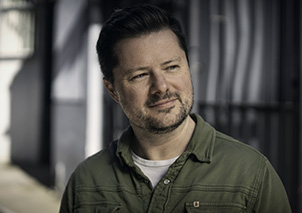
Senior Colourist Sam Chynoweth




